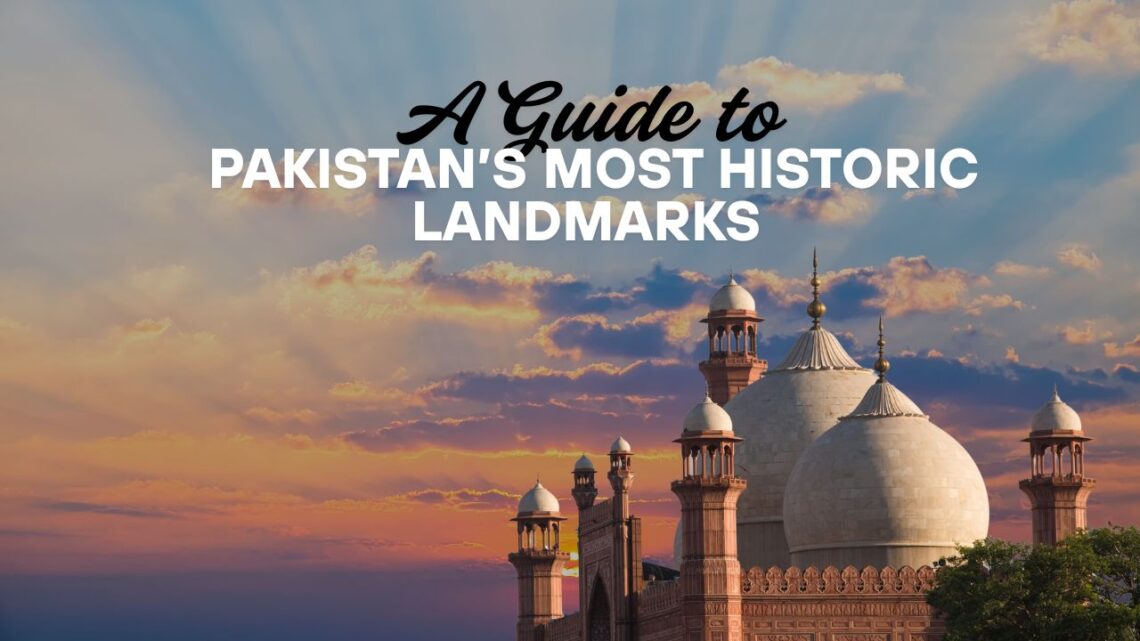Pakistan, a land steeped in history and culture, is home to some of the world’s most remarkable historic landmarks. From ancient archaeological sites that date back thousands of years to architectural marvels of the Mughal era, the country offers a treasure trove for history enthusiasts and travelers alike.
This guide takes you on a journey through Pakistan’s most iconic historic landmarks, exploring their significance, stories, and the unique experiences they offer. Whether you’re a local rediscovering your heritage or a global traveler seeking adventure, these sites will leave you in awe of Pakistan’s rich past.
Here are some of the most Historic Landmarks in Pakistan
Pakistan’s Most Historic Landmarks
1. Mohenjo-Daro: A Window into the Ancient Indus Valley Civilization
Let’s start with one of the oldest landmarks in Pakistan—Mohenjo-Daro, located in Sindh province. Dating back to around 2500 BCE, this UNESCO World Heritage Site is a testament to the advanced urban planning of the Indus Valley Civilization, one of the world’s earliest known societies. Walking through the ruins of Mohenjo-Daro feels like stepping into a time machine. The city’s grid-like layout, with its well-planned streets, drainage systems, and multi-room houses, shows just how sophisticated this ancient civilization was.
One of the most striking features of Mohenjo-Daro is the Great Bath, a large, rectangular pool believed to have been used for religious rituals. Archaeologists also uncovered the famous “Dancing Girl” bronze statue and the “Priest-King” figurine here, which offer glimpses into the artistic and cultural life of the time. The site’s museum is a great place to see these artifacts up close and learn more about the people who lived here thousands of years ago.
Visiting Mohenjo-Daro is a humbling experience, but it’s worth noting that the site faces preservation challenges due to weather and erosion. If you plan to visit, go during the cooler months (November to February) to avoid the scorching Sindh heat, and make sure to bring water and sun protection.
Useful Links for Mohenjo-Daro:
- UNESCO World Heritage Page: https://whc.unesco.org/en/list/138/ – Official UNESCO page with detailed history and preservation updates.
- Pakistan Tourism Development Corporation (PTDC): https://tourism.gov.pk/ – For travel tips and visitor information on Sindh attractions.
- Sindh Tourism Development Corporation: http://www.stdc.gos.pk/ – Local tourism board with guides for visiting Mohenjo-Daro.
2. Taxila: The Cradle of Buddhist Civilization
Moving north to Punjab, Taxila is another UNESCO World Heritage Site that history lovers can’t miss. Located about 30 kilometers from Islamabad, Taxila was a major center of learning and culture from the 6th century BCE to the 5th century CE. It’s often called the “cradle of Buddhist civilization” because of its role in spreading Buddhism across Asia.
Taxila is actually a collection of archaeological sites, with the most notable being Dharmarajika Stupa, Jaulian Monastery, and the ancient city of Sirkap. The Dharmarajika Stupa, built by Emperor Ashoka in the 3rd century BCE, is one of the oldest Buddhist stupas in the world. It’s surrounded by smaller stupas and monasteries, where monks once meditated and studied. The Jaulian Monastery, perched on a hill, offers stunning views of the surrounding landscape, along with well-preserved carvings of Buddha and other figures.
What makes Taxila so fascinating is its blend of influences—Greek, Persian, and Indian—thanks to its position on ancient trade routes. The Taxila Museum is a must-visit, housing artifacts like Gandharan art, coins, and sculptures that reflect this cultural fusion. If you’re visiting, wear comfortable shoes for exploring the sprawling sites, and consider hiring a local guide to bring the history to life.
Useful Links for Taxila:
- UNESCO World Heritage Page: https://whc.unesco.org/en/list/139/ – Official page with historical details and photos of Taxila.
- Taxila Museum (via Punjab Tourism): https://tourism.punjab.gov.pk/ – Information on visiting the museum and nearby sites.
- Pakistan Tourism Development Corporation: https://tourism.gov.pk/ – General travel advice for Punjab attractions.
3. Lahore Fort: A Mughal Masterpiece
No guide to Pakistan’s historic landmarks would be complete without mentioning the Lahore Fort, a sprawling fortress in the heart of Lahore’s Walled City. Built, rebuilt, and expanded over centuries, the fort as we know it today was largely constructed during the Mughal era, particularly under Emperor Akbar in the 16th century. It’s also a UNESCO World Heritage Site, and for good reason—this place is a living museum of Mughal architecture and history.
The fort covers over 20 hectares and is packed with stunning structures like the Sheesh Mahal (Palace of Mirrors), a breathtaking hall adorned with intricate mirror work and frescoes. The Diwan-e-Aam (Hall of Public Audience) and Diwan-e-Khas (Hall of Private Audience) showcase the grandeur of Mughal courts, while the Alamgiri Gate, built by Emperor Aurangzeb, is a popular spot for photos. The fort’s walls and courtyards are filled with stories of emperors, battles, and royal life.
Visiting the Lahore Fort is like walking through a history book. You can feel the echoes of the past as you explore its halls and gardens. Pair your visit with a trip to the nearby Badshahi Mosque (more on that later) for a full day of Mughal splendor. The fort is best visited in the early morning or late afternoon to avoid the midday heat, and don’t forget to bring a camera—the views are incredible.
Useful Links for Lahore Fort:
- UNESCO World Heritage Page: https://whc.unesco.org/en/list/171/ – Official page for the Fort and Shalimar Gardens.
- Punjab Tourism: https://tourism.punjab.gov.pk/ – Visitor information and guides for Lahore attractions.
- Walled City of Lahore Authority: http://www.walledcitylahore.gop.pk/ – Official site with details on the fort and other historic sites in Lahore.
4. Badshahi Mosque: The Jewel of Lahore
Just a stone’s throw from the Lahore Fort stands the Badshahi Mosque, another Mughal masterpiece that’s one of Pakistan’s most iconic landmarks. Built in 1673 by Emperor Aurangzeb, this mosque is a stunning example of Mughal architecture, with its massive red sandstone structure, white marble domes, and towering minarets. It was the largest mosque in the world for over 300 years and can hold up to 100,000 worshippers at a time.
The mosque’s courtyard is a peaceful oasis in the bustling city, offering a place to sit and soak in the beauty of the surroundings. Inside, the prayer hall is adorned with intricate frescoes and stucco work, while the minarets provide panoramic views of Lahore if you’re up for the climb. The Badshahi Mosque isn’t just a place of worship—it’s a symbol of Pakistan’s cultural and religious heritage.
Visiting during sunset is magical, as the golden light bathes the mosque in a warm glow. Be sure to dress modestly (covering your head and shoulders for women) and remove your shoes before entering, as a sign of respect. The mosque is also a great spot for photography, especially with the Lahore Fort in the background.
Useful Links for Badshahi Mosque:
- Walled City of Lahore Authority: http://www.walledcitylahore.gop.pk/ – Information on visiting the mosque and nearby attractions.
- Punjab Tourism: https://tourism.punjab.gov.pk/ – Travel tips for exploring Lahore’s historic sites.
- Pakistan Tourism Development Corporation: https://tourism.gov.pk/ – General visitor information for cultural landmarks.
5. Shalimar Gardens: A Mughal Paradise
Also in Lahore, the Shalimar Gardens are a serene escape that transports you back to the Mughal era. Built in 1641 by Emperor Shah Jahan (the same emperor behind the Taj Mahal), these gardens were designed as a royal retreat and are now a UNESCO World Heritage Site. The gardens are laid out in a classic Mughal style, with three terraces, over 400 fountains, and lush greenery.
Walking through Shalimar Gardens feels like stepping into a painting. The sound of water flowing through the marble channels, the scent of blooming flowers, and the sight of pavilions like the Sawan Bhadon (named after the monsoon season) create a magical atmosphere. The gardens were meant to represent an earthly paradise, and they certainly live up to that vision.
The best time to visit is in spring, when the flowers are in full bloom, but the gardens are beautiful year-round. Bring a picnic, find a shady spot, and enjoy the tranquility. The gardens can get crowded on weekends, so try to visit on a weekday for a more peaceful experience.
Useful Links for Shalimar Gardens:
- UNESCO World Heritage Page: https://whc.unesco.org/en/list/171/ – Official page for the Fort and Shalimar Gardens.
- Punjab Tourism: https://tourism.punjab.gov.pk/ – Visitor guides for Shalimar Gardens and other Lahore attractions.
- Walled City of Lahore Authority: http://www.walledcitylahore.gop.pk/ – Details on the gardens and nearby historic sites.
6. Rohtas Fort: A Military Marvel
Located near Jhelum in Punjab, Rohtas Fort is a 16th-century fortress built by Sher Shah Suri to defend against Mughal attacks. This massive fort, another UNESCO World Heritage Site, is a masterpiece of military architecture, with its 4-kilometer-long walls, 12 gates, and strategic design. It was never taken by force, a testament to its strength and ingenuity.
Exploring Rohtas Fort is an adventure in itself. The fort’s rugged stone walls, bastions, and gates like the Sohail Gate and Talaqi Gate are impressive, while the Haveli Man Singh—a blend of Hindu and Islamic architecture—offers a glimpse into the fort’s history. The fort also has a small village inside its walls, where locals still live, adding a unique charm to the experience.
Rohtas Fort is a bit off the beaten path, but it’s worth the trip for history buffs. The drive from Islamabad takes about two hours, and the fort is best explored with a guide who can explain its military significance. Wear sturdy shoes, as the terrain can be uneven, and bring plenty of water, especially if you’re visiting in the warmer months.
Useful Links for Rohtas Fort:
- UNESCO World Heritage Page: https://whc.unesco.org/en/list/586/ – Official page with historical details and photos.
- Punjab Tourism: https://tourism.punjab.gov.pk/ – Travel information for visiting Rohtas Fort.
- Pakistan Tourism Development Corporation: https://tourism.gov.pk/ – General travel advice for Punjab attractions.
7. Makli Necropolis: The City of the Dead
In Sindh, near the city of Thatta, lies the Makli Necropolis, one of the largest funerary sites in the world. Spanning over 10 square kilometers, this UNESCO World Heritage Site is home to nearly half a million tombs and graves, dating from the 14th to the 18th centuries. Makli was a burial ground for rulers, scholars, and saints during the Samma, Arghun, Tarkhan, and Mughal periods, making it a fascinating record of Sindh’s history.
The tombs at Makli are architectural wonders, with intricate stone carvings, glazed tiles, and domes that reflect a blend of Islamic, Persian, and local styles. Some of the most notable tombs belong to Jam Nizamuddin II, a 15th-century Samma ruler, and Isa Khan Tarkhan, whose mausoleum is adorned with stunning blue tiles. The site’s eerie beauty, combined with its historical significance, makes it a must-visit.
Makli is best visited early in the morning to avoid the heat, and a local guide can help you navigate the sprawling site. The necropolis is about an hour’s drive from Karachi, making it a great day trip for those exploring Sindh.
Useful Links for Makli Necropolis:
- UNESCO World Heritage Page: https://whc.unesco.org/en/list/143/ – Official page with historical details and photos.
- Sindh Tourism Development Corporation: http://www.stdc.gos.pk/ – Local tourism board with guides for visiting Makli.
- Pakistan Tourism Development Corporation: https://tourism.gov.pk/ – General travel advice for Sindh attractions.
8. Hiran Minar: A Tribute to a Beloved Pet
In Sheikhupura, Punjab, Hiran Minar is a unique Mughal-era monument built by Emperor Jahangir in 1606 as a tribute to his pet deer, Mansraj. The site includes a large water tank, a pavilion, and a 30-meter-high minaret decorated with hunting scenes—a rare example of a monument dedicated to an animal.
The story behind Hiran Minar is touching: Jahangir was so fond of his deer that he ordered the construction of this complex to honor its memory after its death. The minaret stands in the middle of a serene park, surrounded by a water tank where the emperor would hunt. The pavilion, with its arched design, offers a peaceful spot to relax and take in the surroundings.
Hiran Minar is a lesser-known gem, perfect for a quiet visit. It’s about an hour’s drive from Lahore, and the site is ideal for a picnic or a leisurely stroll. The best time to visit is in the cooler months, when the park is lush and green.
Pakistan’s historic landmarks are a testament to its diverse and vibrant past, from the ancient cities of the Indus Valley to the grandeur of the Mughal Empire. Each site tells a story—of innovation, faith, power, and artistry—that continues to captivate visitors from around the world. Whether you’re exploring the ancient ruins of Mohenjo-Daro, marveling at the Badshahi Mosque’s domes, or walking through the serene Shalimar Gardens, you’ll find a deep connection to history at every turn.
Useful Links for Hiran Minar:
- Punjab Tourism: https://tourism.punjab.gov.pk/ – Visitor information for Hiran Minar and other Punjab attractions.
- Pakistan Tourism Development Corporation: https://tourism.gov.pk/ – General travel advice for cultural landmarks.
- Walled City of Lahore Authority: http://www.walledcitylahore.gop.pk/ – Information on Mughal-era sites in Punjab.
When planning your visit, keep in mind the weather and local customs. Dress modestly at religious sites, stay hydrated, and consider hiring local guides to enrich your experience. Pakistan’s historic landmarks are not just places to visit—they’re windows into a past that continues to shape the country’s identity today.

























